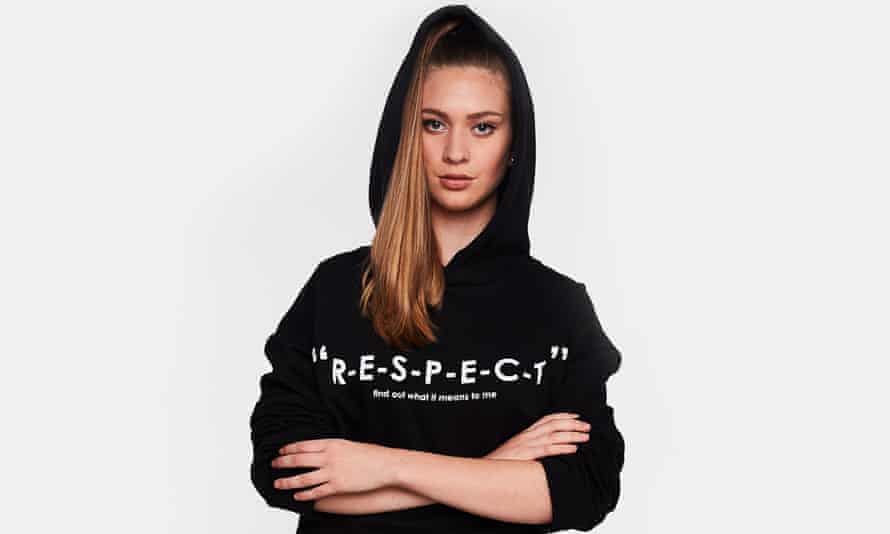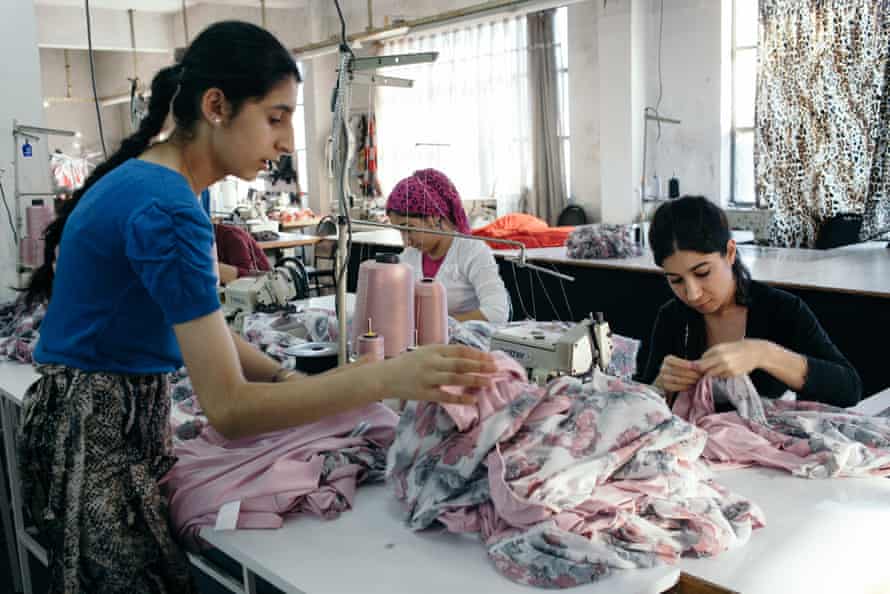Según TheGuardian, de un precio medio de venta de 26,66 euros para esta prenda (una sudadera de Zara) sólo un euro se destina a remunerar a los trabajadores que la producen.
The truth about fast fashion: can you tell how ethical your clothing is by its price?
The Zara R-E-S-P-E-C-T hoodie, for which researchers attempted to unpick the labour costs involved. Photograph: Public Eye/Noura Gauper
Thu 29 Jul 2021 06.00 BST
What is the true cost of a Zara hoodie? In April 2019, David Hachfeld of the Swiss NGO Public Eye, along with a team of researchers and the
Clean Clothes Campaign, attempted to find out. They chose to analyse a black, oversized top from Zara’s flagship Join Life sustainability line, which was printed with lyrics made famous by Aretha Franklin: “R-E-S-P-E-C-T: find out what it means to me”. It was an apt choice, because the idea was to work out whether any respect had been paid to the workers involved in the garment’s production, and
how much of the hoodie’s average retail price, €26.66 (£22.70), went into their pockets.
This was no simple assignment. It took several people six months, involved badgering Zara’s parent company, Inditex, over email, slowly getting limited information in return, and interviewing dozens of sources on the ground in Izmir, Turkey, where the garment was made. The researchers analysed financial results and trading data, and consulted with experts in pricing and production. It was, Hachfeld says on the phone, with dry understatement, “quite a huge project”.
Their research suggested that the biggest chunk of the hoodie’s retail price – an estimated €10.26 – went back into Zara, to cover retail space and staff wages. The next biggest slice, after VAT at €4.44, was profit for Inditex/Zara, at €4.20. Their research suggested that the textile factory in Izmir received just €1.53 for cutting the material, sewing, packing and attaching the labels, with €1.10 of that being paid to the garment workers for the 30-minute job of putting the hoodie together. The report concluded that workers could not have received anything like a living wage, which the Clean Clothes Campaign defined, at the time the report was released, as a gross hourly wage of €6.19.
When the research was
covered by the media at the time, Zara said the report was “based on erroneous premises and inaccurate reporting”, that the €7.76 sourcing price was wrong and that the workers were “paid more than the amounts mentioned in Public Eye’s report”. But at the time and when I contacted Zara for this article, the company declined to set out in greater detail where the research was inaccurate.
Workers in a small garment factory in Istanbul. Photograph: NurPhoto/Getty Images
What is clear is that trying to find out the true production cost of a garment is a tortuous and potentially fruitless process – even when assessing a major high street retailer’s flagship “sustainability” line.
Hachfeld points out that Zara is by no means uniquely opaque. It is doing more than many clothing brands and has long-term commitments in place
to work towards living wages. “They are launching initiatives and consultations with trade unions. But the question remains: when will they deliver on it?” he says. Vanishingly few retailers guarantee living wages across their
vast, complex supply chains. According to the not-for-profit group
Fashion Revolution, only two of the world’s 250 largest fashion brands (OVS and Patagonia) disclose how many of their workers are paid a living wage – despite the kind of resources that make billionaires of founders. Forbes estimates that Zara’s founder, Amancio Ortega, is worth $77bn (£55bn) and that H&M’s founder, Stefan Persson, is worth $21.3bn; the Sunday Times puts the wealth of
Boohoo’s co-founder, Mahmud Kamani, at £1.4bn.
Throughout fashion, the numbers just don’t add up. High-street clothing has been getting cheaper and cheaper for decades. A major reason why, according to Gordon Renouf, the CEO of the
fashion ethics comparison app Good on You, is that so many western brands have “moved from onshore production 40 years ago to larger offshore production”. Often, the countries they have chosen have “much lower wage costs, weaker labour movements and laxer environmental regulations”. Of course, we know all this, but we have also become accustomed to reaping the benefits. Our perception of what clothing should cost – and how much of it we need – has shifted.
In 1970, for example, the average British household spent 7% of its annual income on clothing. This had fallen to 5.9% by 2020. Even though we are spending less proportionally, we tend to own more clothes. According to the UN, the average consumer buys 60% more pieces of clothing – with half the lifespan – than they did 15 years ago. Meanwhile, fashion is getting cheaper: super-fast brands such as Shein (which sells tie-dye crop tops for £1.49) and Alibaba (vest tops for $2.20), have boomed online, making high-street brands look slow-moving and expensive by comparison.
But the correlation between price and ethics is knotty, to say the least. The conversation about sustainable fashion tends to be dominated by expensive designer brands: at Stella McCartney, for example, a wool-cotton jumper costs £925; at Another Tomorrow, each $520 sustainable viscose carbon-offset scarf neck blouse features a QR code in the label that outlines every stage of its “provenance journey”.
On the high street, many who proudly opt out of shopping at Primark or Boohoo for ethical reasons may be unaware that most reassuringly mid-priced brands don’t guarantee workers living wages or produce clothing without using environmentally harmful materials. A garment’s price is often more about aspiration and customer expectation than the cost of production. Hachfeld points out that the Zara hoodie was priced higher in Switzerland (CHF 45.90; €39.57), where Zara is positioned as a mid-range brand, than in Spain (€25.95), where it is perceived as more mainstream and affordable.
‘Provenance journey’ ... Another Tomorrow scarf neck blouse.
Online, debates about the price of clothing can get heated. The sustainable-fashion writer Aja Barber, for example, uses the phrase “exploitation prices” to refer to very cheap clothes, such as the
8p bikini offered by the Boohoo brand Pretty Little Thing last autumn. “Either the company or the garment worker is taking the hit, and most likely it’s not the company, because that wouldn’t be a profitable business model,” she says.
Barber has a personal threshold in mind when she buys an item. “Any time a dress is under £50, you really need to break down the labour on it,” she says. “Think about what you get paid hourly – think, could a person make this dress in three hours?” She doesn’t base this calculation on local wages in the global south, either, which are so much lower “because of years of colonialism and oppression”. She buys new clothes infrequently and tries to avoid polyester, which is made with fossil fuels and generally used in garments to make them cheaper.
Barber gets annoyed by the accusations of snobbery that ripple through social media when anyone criticises super-cheap brands. Largely, she says, these comments come from middle-class people “who want to participate in the system and not feel bad about it”. In her view, fast fashion is propped up not by those with very low disposable incomes, but by middle-class overconsumption.
The only way to tell if a garment has been ethically produced is by combing through the details on the manufacturer’s website (although many brands give little or no information) and checking out its rating on Good on You, which compares fashion brands on the basis of their impact on the planet, people and animals. Even among brands that have launched with sustainability as their USP, greenwashing is rife. Renouf warns against those that talk vaguely about being “natural” and “fair”, or bang on about recycled packaging, without giving details about, say, the materials they use or whether they engage with unions in their factories.
For the fashion retailer Sam Mabley, the idea that fashion can be ethical only if it is expensive is a myth. Mabley runs
a sustainable fashion store in Bristol; he thought it was a shame that he was selling so many ethical T-shirts at around the £30 price point. Usually, he says, such T-shirts are created in small batches, by “cool indie brands who do printed designs – a lot of the work is in the design”. He decided to invert that business model, ramping up the scale in order to get bigger discounts from suppliers and creating plain, organic cotton, ethically produced Ts in black and white for £7.99. With just a month of social media promotion, he secured 4,000 orders.
‘Buying power’ ... a Yes Friends T-shirt by Sam Mabley.
He believes it would be fairly easy for fast-fashion brands to use their buying power to “drive change for millions of workers around the world” and guarantee their factories paid living wages, without drastically affecting their margins. He is not alone in this view: Jenny Hulme, the head of buying at the sustainable fashion mainstay People Tree, believes ethical production is necessary and possible in every part of the market. “If you order in big volumes, it does reduce price – if a company really wants to improve, it can,” she says.
The reality of high-street clothes shopping is still very far from this ideal. Apart from a few “sustainable” lines produced by the big fast-fashion brands – which I am loath to recommend, because of so many accusations of greenwashing – it is almost impossible to find new, ethical clothing at rock-bottom prices, because the business models that have enabled clothing to get this cheap rely on inexpensive, environmentally damaging fabrics and very low wages.
That may leave anyone wanting to dress ethically on a high-street purse feeling out of options, although Renouf points out that buying better is possible at every budget. That is why, he says, Good on You aims to “provide ratings for as many brands as possible, rather than simply promoting the most sustainable brands”. You could, for example, move from an ultra-rapid fashion brand to a more engaged high-street fast-fashion brand, which might not cost much more, but still could constitute progress.
Buying fewer, but better-quality, items might save you money overall and is the most consistent advice you will hear from fashion campaigners. “Buy the best quality that you can afford, perhaps in end-of-season sales or by buying a thick jumper in the middle of summer to wear the next winter,” says Hulme.
Stepping out of the trend cycle, and avoiding brands that trade on planned obsolescence, is another avenue to explore. For example, Patrick Grant, a judge on the BBC’s The Great British Sewing Bee, explains that his
Community Clothing brand aims to give shoppers more bang for their buck by stocking basics rather than continually designing new collections (it also does without retail space and marketing). Working to slimmer margins means he can invest in good fabric, but keep prices fairly low: his £49 hoodies are made from 470g 100% loopback cotton, a thicker, more durable fabric than you might find for a similar price on the high street.
A blazer from the ethical brand Lora Gene. Photograph: Lora Gene
For those who can afford mid-high street prices, researching small, sustainable brands might glean results. A quick look at the Zara website today shows silk dresses selling for as much as £199, with plenty of others at £49.99, while H&M-owned &OtherStories sells blazers for about £120; Barber points out that at these prices, shoppers could switch to ethical brands including Lora Gene, for which she has designed a collection, and Ninety Percent. (There is
a dress I like the look of for £64 in the Ninety Percent sale; a mustard Lora Gene blazer is £139.)
If those prices are out of reach, swapping clothes, shopping secondhand, repairing and rethinking what you already have, and occasionally renting for special occasions can all be cheaper – even free – alternatives.
Voting with your wallet will only go so far, however, and won’t be possible for many people who are struggling, as the
number of people in poverty in the UK soars to 15 million. Questioning the magical thinking of rock-bottom prices is not about blaming the consumer. Instead, you could write to MPs and CEOs and demand that they do something about living wages and the environmental cost of fashion. The responsibility lies with brands, and with the government, which should be held to account for a broken system.






